Book contents
- Frontmatter
- Contents
- Contributors
- Preface
- Acknowledgments
- 1 Pure Premium Modeling Using Generalized Linear Models
- 2 Applying Generalized Linear Models to Insurance Data: Frequency/Severity versus Pure Premium Modeling
- 3 Generalized Linear Models as Predictive Claim Models
- 4 Frameworks for General Insurance Ratemaking: Beyond the Generalized Linear Model
- 5 Using Multilevel Modeling for Group Health Insurance Ratemaking: A Case Study from the Egyptian Market
- 6 Clustering in General Insurance Pricing
- 7 Application of Two Unsupervised Learning Techniques to Questionable Claims: PRIDIT and Random Forest
- 8 The Predictive Distribution of Loss Reserve Estimates over a Finite Time Horizon
- 9 Finite Mixture Model and Workers’ Compensation Large-Loss Regression Mixture Model and Workers’ Compensation Large-Loss Regression Analysis
- 10 A Framework for Managing Claim Escalation Using Predictive Modeling
- 11 Predictive Modeling for Usage-Based Auto Insurance
- Index
- References
3 - Generalized Linear Models as Predictive Claim Models
Published online by Cambridge University Press: 05 August 2016
- Frontmatter
- Contents
- Contributors
- Preface
- Acknowledgments
- 1 Pure Premium Modeling Using Generalized Linear Models
- 2 Applying Generalized Linear Models to Insurance Data: Frequency/Severity versus Pure Premium Modeling
- 3 Generalized Linear Models as Predictive Claim Models
- 4 Frameworks for General Insurance Ratemaking: Beyond the Generalized Linear Model
- 5 Using Multilevel Modeling for Group Health Insurance Ratemaking: A Case Study from the Egyptian Market
- 6 Clustering in General Insurance Pricing
- 7 Application of Two Unsupervised Learning Techniques to Questionable Claims: PRIDIT and Random Forest
- 8 The Predictive Distribution of Loss Reserve Estimates over a Finite Time Horizon
- 9 Finite Mixture Model and Workers’ Compensation Large-Loss Regression Mixture Model and Workers’ Compensation Large-Loss Regression Analysis
- 10 A Framework for Managing Claim Escalation Using Predictive Modeling
- 11 Predictive Modeling for Usage-Based Auto Insurance
- Index
- References
Summary
Review of Loss Reserving
Background
A typical property and casualty (P&C) insurance will indemnify the insured against events that occur within a defined period. From an accounting viewpoint, a liability accrues to the insurer at the date of occurrence of an indemnified event. From that date the insurer's accounts are therefore required to recognize the quantum of this liability to the extent that it has not been settled.
However, there will be an inevitable delay between the occurrence of the event and notification of an associated claim to the insurer, and a further delay between notification and settlement of the claim. These delays can be considerable. For example, in casualty classes of business, such as auto bodily injury liability, a typical average period from claim occurrence to settlement might be 3 or 4 years, with some claims remaining unsettled for 10 to 20 years.
During the period between occurrence and notification, even the existence of the claim will be unknown to the insurer. Between notification and settlement its existence will be known but its ultimate quantum unknown since it may depend on the outcome of negotiation between insurer and insured, or on an adversarial legal process. The insurer is obliged to make accounting provision for the claim despite these shortfalls in knowledge.
The balance sheet item recognizing the insurer's liability is called the loss reserve, and the determination of this reserve as loss reserving. The reserve will certainly include the liability for the cost of the claims themselves but, depending on the accounting regime, may also include allowance for other associated costs such as loss adjustment expenses.
For long tail lines of insurance, the loss reserve may amount to several times annual premium income, and therefore may amount to a large multiple of typical annual profit. As a result, a modest proportionate error in the loss reserve can impinge heavily on annual profit, and so accuracy of the reserve is a matter of considerable importance.
The estimation of loss reserves in practice relies on a wide variety of models and methodologies. It is not feasible to review them all here. For that, refer to Taylor (2000) and Wüthrich and Merz (2008).
- Type
- Chapter
- Information
- Predictive Modeling Applications in Actuarial Science , pp. 60 - 99Publisher: Cambridge University PressPrint publication year: 2016



